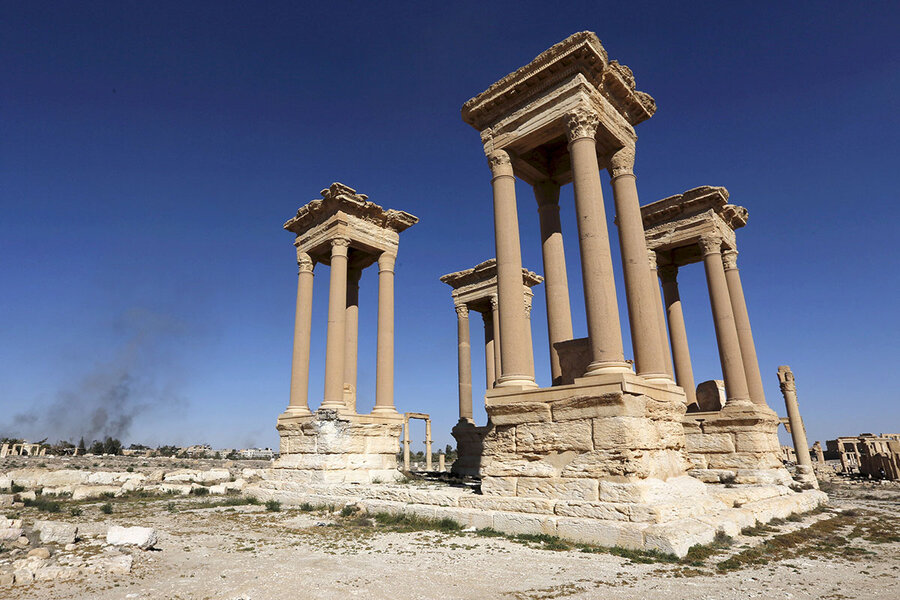Recaptured by ISIS, ancient Palmyra loses two more monuments to antiquities destruction
The ancient "pearl of the desert," Palmyra, has witnessed another destruction of its heritage, according to Syrian officials.
After re-capturing the Syrian city in December, militants from the so-called Islamic State in Iraq and Syria (ISIS) have destroyed the Tetrapylon, one of Palmyra's most famous ancient monuments, and part of its Roman theater, local authorities confirmed Friday, threatening millennia-old roots of the Middle East's history.
“This is a horror film and we will see more of it, as long as the city is under their control it will remain a hostage,” Maamoun Abdulkarim, the country’s director of antiquities, told The Guardian.
Mr. Abdulkarim indicated that he had learned of the damage 10 days earlier, but waited to release the details until he received proof in satellite images.
Those images confirmed that the Tetrapylon, a Roman-era group of pillars near the city's historic entrance, now appears to have only four of its 16 columns still standing, with its stone base covered in rubble.
Parts of the facade of the city’s Roman theatre, where St. Petersburg’s Mariinsky orchestra performed last May after Syrian and Russian forces temporarily reclaimed the city from ISIS, also appeared to be demolished.
Yet, for this ancient city that was once a Silk Road oasis, ISIS has never had mercy.
In 2015, when ISIS first seized the UNESCO World Heritage Site, the militants rampaged through the desert city’s antiquities and ruins, including the iconic Temple of Bel, as The Christian Science Monitor reported at the time. They also beheaded Khaled al-Asaad, a world-renowned archeologist.
Palmyra is just one example of many historic sites in Syria damaged during the country’s nearly six-year civil war. Citing religion, ISIS claimed that these relics they demolished were un-Islamic, since they predate the religion itself.
"The Prophet Muhammad commanded us to shatter and destroy statues," a member of the terror group said in a video in 2015. "This is what his companions did later on, when they conquered lands."
Experts say the group's latest attempts to "cleanse" the history and traditions of Syria have consequences that go far beyond the region, putting the world's history at risk.
"This isn't just about Middle Eastern history, these are the wellsprings of the entire global culture," British historian Tom Holland told CNN in 2015, after the first bout of destruction in Palmyra. "Mesopotamia, Iraq, Syria, this is the wellspring of global civilization. It really couldn't be higher stakes in terms of conservation."
But the pointed destruction goes beyond architecture and art.
"This is a way to destroy identity," Irina Bokova, the director general of the UN Education, Scientific and Cultural Organization (UNESCO), told the Monitor in 2014, referring to ISIS's attempt to erase the cultural heritage of Christians, Yazidis, and other minorities in the region. "You deprive them of their culture, you deprive them of their history, their heritage, and that is why it goes hand in hand with genocide. Along with the physical persecution they want to eliminate – to delete – the memory of these different cultures."
The destruction has a financial motivation, as well; the extremist group is believed to finance itself, in part, from the illegal sale of antiquities. Some observers, however, believe a main incentive is the exposure that accompanies the loss of each ruin.
“I think it's very clear that they gain masses of propaganda, masses of publicity every time they blow up or destroy something that is valued by the world,” Washington Post correspondent Liz Sly told NPR in 2015. “And they seem to take great delight in the attention that they get from doing these things.”
Abdulkarim, worried about the future of these structures as ISIS continues its occupation of Palmyra, has called for the world's help.
"This is a scandal. Palmyra is occupied and there is no outrage from the international community," he told The Guardian. "We are trying to protect a civilization. It's beyond political considerations. There needs to be international solidarity."
This report contains materials from Reuters.







